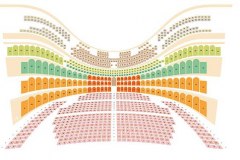La Bayadère Ballet
February 2026 | ||||||
|---|---|---|---|---|---|---|
Mo | Tu | We | Th | Fr | Sa | Su |
La Bayadère
Music by Ludwig Minkus
Ballet in three acts
Plot outline
Khudekov's libretto for La Bayadère (meaning The Temple Dancer or The Temple Maiden) tells the story of the bayadère Nikiya and the warrior Solor, who have sworn eternal fidelity to each other. The High Brahmin, however, is also in love with Nikiya and learns of her relationship with Solor. Moreover, the Rajah Dugmanta of Golconda has selected Solor to wed his daughter Gamzatti (or Hamsatti, as she is known in the original production), and Nikiya, unaware of this arrangement, agrees to dance at the couple's betrothal celebrations.
In his effort to have Solor killed and have Nikiya for himself, the jealous High Brahmin informs the Rajah that the warrior has already vowed eternal love to Nikiya over a sacred fire. But the High Brahmin's plan backfires when, rather than becoming angry with Solor, the Rajah decides that it is Nikiya who must die. Gamzatti, who has eavesdropped on this exchange, summons Nikiya to the palace in an attempt to bribe the bayadère into giving up her beloved. As their rivalry intensifies, Nikiya picks up a dagger in a fit of rage and attempts to kill Gamzatti, only to be stopped in the nick of time by Gamzatti's ayah. Nikiya flees in horror at what she has almost done. As did her father, Gamzatti vows that the bayadère must die.
At the betrothal celebrations Nikiya performs a somber dance while playing her veena. She is then given a basket of flowers which she believes are from Solor, and begins a frenzied and joyous dance. Little does she know that the basket is from Gamzatti, who has concealed beneath the flowers a venomous snake. The bayadère then holds the basket too close and the serpent bites her on the neck. The High Brahmin offers to give Nikiya the antidote to the poison if she will renounce her vow to Solor, but she chooses death rather than life without her beloved.
In the next scene the depressed Solor smokes opium. In his dream-like euphoria he has a vision of Nikiya's shade (or spirit) in a nirvana among the star-lit mountain peaks of the Himalayas called The Kingdom of the Shades. Here, the lovers reconcile among the shades of other bayadères. (In the original 1877 production, this scene took place in an illuminated enchanted palace in the sky.) When Solor awakes, preparations are underway for his wedding to Gamzatti.
In the temple where the wedding is to take place the shade of Nikiya haunts Solor as he dances with Gamzatti. When the High Brahmin joins the couple's hands in marriage, the gods take revenge for Nikiya's murder by destroying the temple and all of its occupants. In an apotheosis, the shades of both Nikiya and Solor are reunited in death and eternal love.
Program and cast
Conductor: Fayçal Karoui
Coreography: Benjamin Pech
Assistant coreographers: Hervé Courtain; Isabelle Guérin
Set designer: Ignasi Monreal
Costume designer: Anna Biagiotti
Lighting designer: Vinicio Cheli
Guest: Sae Eun Park 3,5; Paul Marque 3, 5
CAST
Alessandra Amato, Rebecca Bianchi, Susanna Salvi, Alessio Rezza
Federica Maine, Marianna Suriano, Claudio Cocino, Michele Satriano
Teatro dell’Opera di Roma Orchestra, Étoiles, Primi Ballerini, Solisti and Corps de Ballet
with the partecipation of Allievi della Scuola di Danza del Teatro dell’Opera di Roma
A Teatro dell’Opera di Roma production
Teatro dell´Opera di Roma Teatro Costanzi
A new way to discover the finest details in different opera houses, theatres one can explore from home in advance through the revolutionary GOOGLE PERFORMING ARTS PROJECT. CLICK ON THE LINK TO SEE THE THEATER.
The Teatro dell'Opera, from its building (1879), at Domenico Costanzi’s request (1810-1898), and 1926, when it was bought by the then Governor of RomE, bore the name of Domenico Costanzi, building contractor and impresario, who committed the building to the Milanese architect Achille Sfondrini (1836-1900), specialized in theatre building and renovation. Built in 18 months on the area prevIously occupied by Heliogabalus’ villa, it was inaugurated on November 27th, 1880 with Semiramide by G. Rossini, conducted by the Maestro Giovanni Rossi, in the presence of the King and Queen of Italy.
Sfrondini’s design privileges the acoustic effect, by conceiving the interior structure as a "resonance chamber": as is particularly evident from the horseshoe shape. At the beginning, the theatre, with a seating capacity of 2,212 spectators, had three tiers of boxes, an amphitheatre, a gallery. All was surmounted by a dome with splendid frescoes by Annibale Brugnoli.
Costanzi invested all his personal assets in the venture. However, due to the despotic refusal of the City Council to redeem the theatre, Costanzi was obliged to manage it himself. Despite the fact that he had to deal with huge financial problems, under his management the opera house held many world premières of such operas as Cavalleria Rusticana (on May 17th, 1890) and L'Amico Fritz(October 31st 1891), both by Pietro Mascagni, who then became very well known.
For a brief period, the theatre was managed by the founder's son, Enrico Costanzi, who contributed to other great premières: Tosca by Giacomo Puccini (January 14th, 1900) and Le Maschere (January 17th, 1901). In 1907, the Teatro Costanzi was managed by the impresario Walter Mocchi (1870-1955) on behalf of the Società Teatrale Internazionale e Nazionale (STIN).
In 1912 Emma Carelli (1877-1928), Mocchi's wife, became the managing director of the new «Impresa Costanzi», named as such following various changes in the company structure. With Rome City Council’s purchase of Costanzi company, the theatre became “Teatro Reale dell'Opera” and a partial rebuilding was commissioned to the architect Marcello Piacentini. Closed on November 15th, 1926, it was re-opened on February 27th, 1928 with the opera Nerone by Arrigo Boito, conducted by the Maestro Gino Marinuzzi.
With the advent of the Republic, the theatre gained the current name of Teatro dell'Opera. In 1958, the building was further remodeled and modernised at the request of the Rome City Council. In over a century, the Teatro dell’Opera has seen its prestige increase internationally. During the several seasons, the most acclaimed voices worldwide followed one another: Enrico Caruso; Beniamino Gigli; Aureliano Pertile; Giacomo Lauri-Volpi; Claudia Muzio; Maria Caniglia; Maria Callas; Renata Tebaldi; Montserrat Caballé; Marilyn Horne; Raina Kabaivanska; Mario Del Monaco; Franco Corelli; Giuseppe Di Stefano; Tito Gobbi; Alfredo Kraus; Ruggero Raimondi; José Carreras; Placido Domingo and Luciano Pavarotti. Among the finest conductors, we can mention Otto Klemperer, Arturo Toscanini, Victor De Sabata, Marinuzzi,Vittorio Gui, Tullio Serafin, Von Karajan, Gianandrea Gavazzeni, Carlo Maria Giulini, Georg Solti, Claudio Abbado, Georges Prêtre, Zubin Mehta, Lorin Maazel, Mstislav Rostropovich, Giuseppe Patanè, Giuseppe Sinopoli, Wolfgang Sawallisch, Nino Sanzogno, Gianluigi Gelmetti and since 2008 the Maestro Riccardo Muti.
How to reach Teatro dell'Opera
Piazza Beniamino Gigli, 7
METRO
Linea A - REPUBBLICA TEATRO DELL'OPERA stop
BUS
Via Nazionale - H, 40, 60, 64, 70, 71, 170, 116T
Via Depretis - 70, 71
Via Cavour - 16, 75, 84, 150 (festivo), 360, 590, 649, 714
Stazione Termini - 16, 38, 75, 86, 90, 217, 310, 360, 649, 714
TAXI
phone number - 06.3570

 EN
EN DE
DE IT
IT FR
FR ES
ES RU
RU JP
JP RO
RO
 Seating plan
Seating plan 